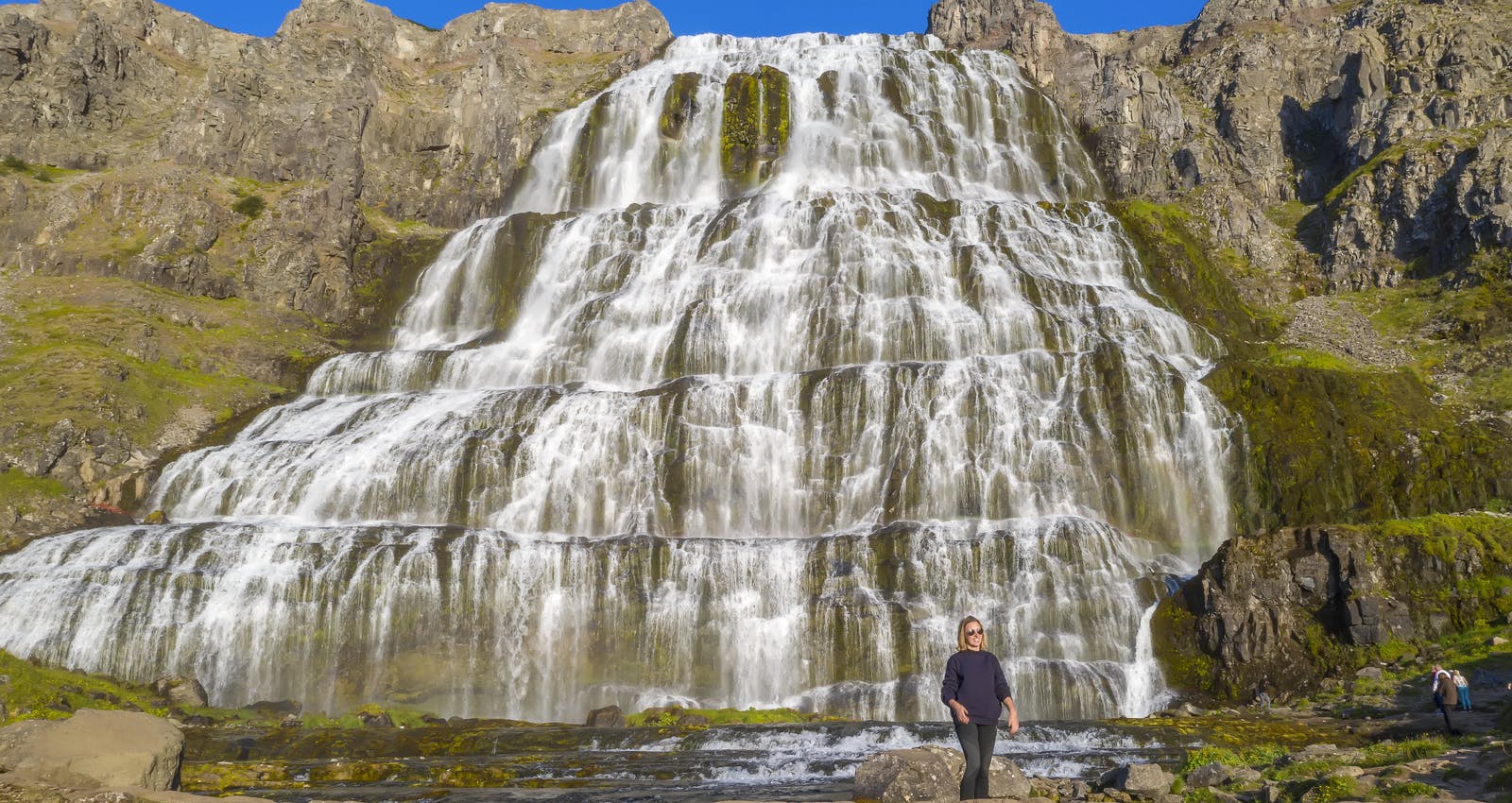
Guide to Dynjandi Waterfall in Iceland
Dynjandi, also known as Fjallfoss, is situated in the Northwestern part of Iceland, specifically in the Westfjords region. This remote location adds to the allure of the waterfall as visitors embark on a journey through rugged terrains and picturesque landscapes to reach this natural wonder. With its 100 metres (approximately 330 feet) of height, it is the largest waterfall in the Westfjords.
Below Dynjandi, you will find a series of waterfalls: Bæjarfoss, Hrísvaðsfoss, Göngumannafoss, Strompgljúfrafoss, Hæstahjallafoss. In 1981, Dynjandi and the other waterfalls in the Dynjandisá area and their environs received protection as natural monuments.
The Westfjords, characterised by deep fjords, towering cliffs, and a sense of isolation, provide a unique backdrop for Dynjandi. The waterfall is nestled in the Arnarfjörður Bay, surrounded by mountains that enhance the grandeur of this natural spectacle. The journey to Dynjandi takes travellers off the beaten path, offering a glimpse into Iceland's raw and untamed beauty.
The name "Dynjandi" itself holds significance and adds to the waterfall's mystique. In Icelandic, "Dynjandi" translates to "thunderous" or "resounding." This name perfectly encapsulates the essence of the waterfall, as its cascading waters create a constant and powerful roar that echoes through the surrounding landscape.
Size of Dynjandi Waterfall
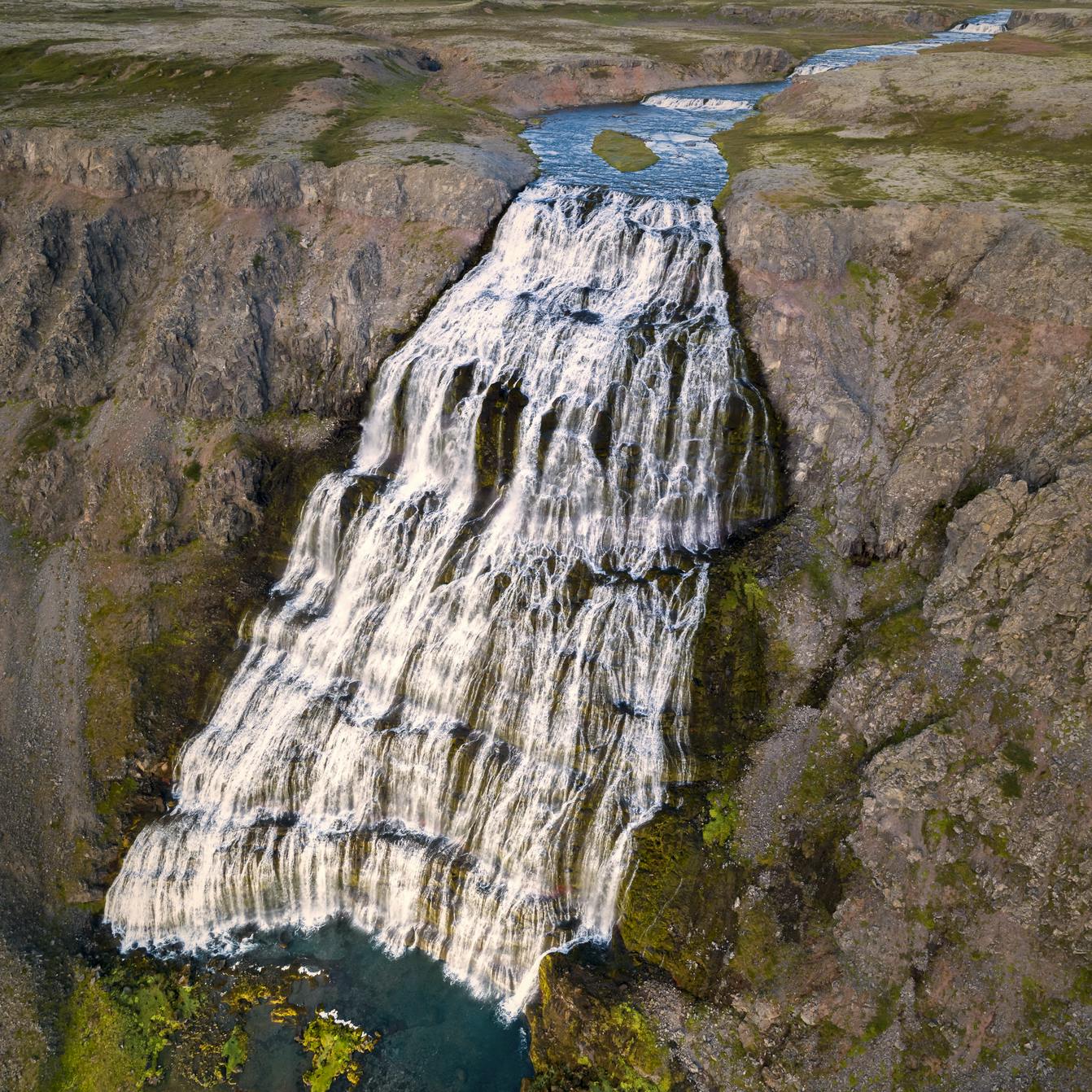
Dynjandi is the largest waterfall in the Westfjords region of Iceland, and its size is impressive, contributing to its majestic appearance. The waterfall is a multi-tiered cascade that descends a total of around 100 metres (328 feet) in a distinctive trapezoidal shape. Its width spans 30 metres (98 feet) at the top and widens to 60 metres (196 feet) at the bottom.
During the summer, Dynjandi showcases a robust flow rate, reaching up to eight cubic metres per second (282 cubic feet). In the winter, this flow diminishes considerably, dropping to as little as one cubic metre per second (35 cubic feet).
Surrounding Area
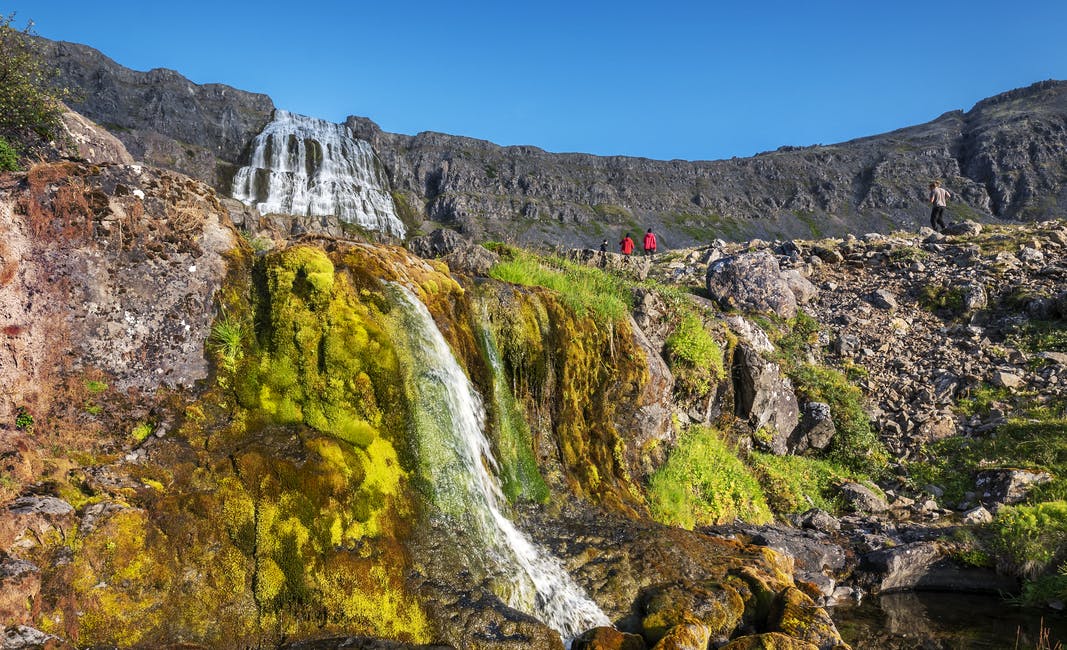
Beyond the waterfall itself, the surroundings add to the overall experience. The Arnarfjörður Bay, framed by towering cliffs, provides a tranquil backdrop to the thunderous spectacle. The remote and untouched nature of the Westfjords amplifies the sense of serenity, creating a moment of connection with the raw beauty of Iceland.
Dynjandi In Different Seasons
Dynjandi's allure is not confined to a particular season; it captivates visitors throughout the year. The waterfall takes on a different character in winter, as the surrounding landscape is blanketed in snow and ice. The contrast between the frozen terrain and the flowing water creates a magical scene. In summer, the verdant hillsides and the longer daylight hours provide a different but equally enchanting backdrop.
Flora and Fauna
The journey to Dynjandi offers more than a visual feast; it provides an opportunity to appreciate Iceland's unique flora and fauna. The trail leading to the waterfall is adorned with vibrant wildflowers, adding a splash of colour to the rugged landscape. Birdwatchers may also spot seabirds soaring above the cliffs, adding to the immersive experience of nature.
Best Time to Visit Dynjandi
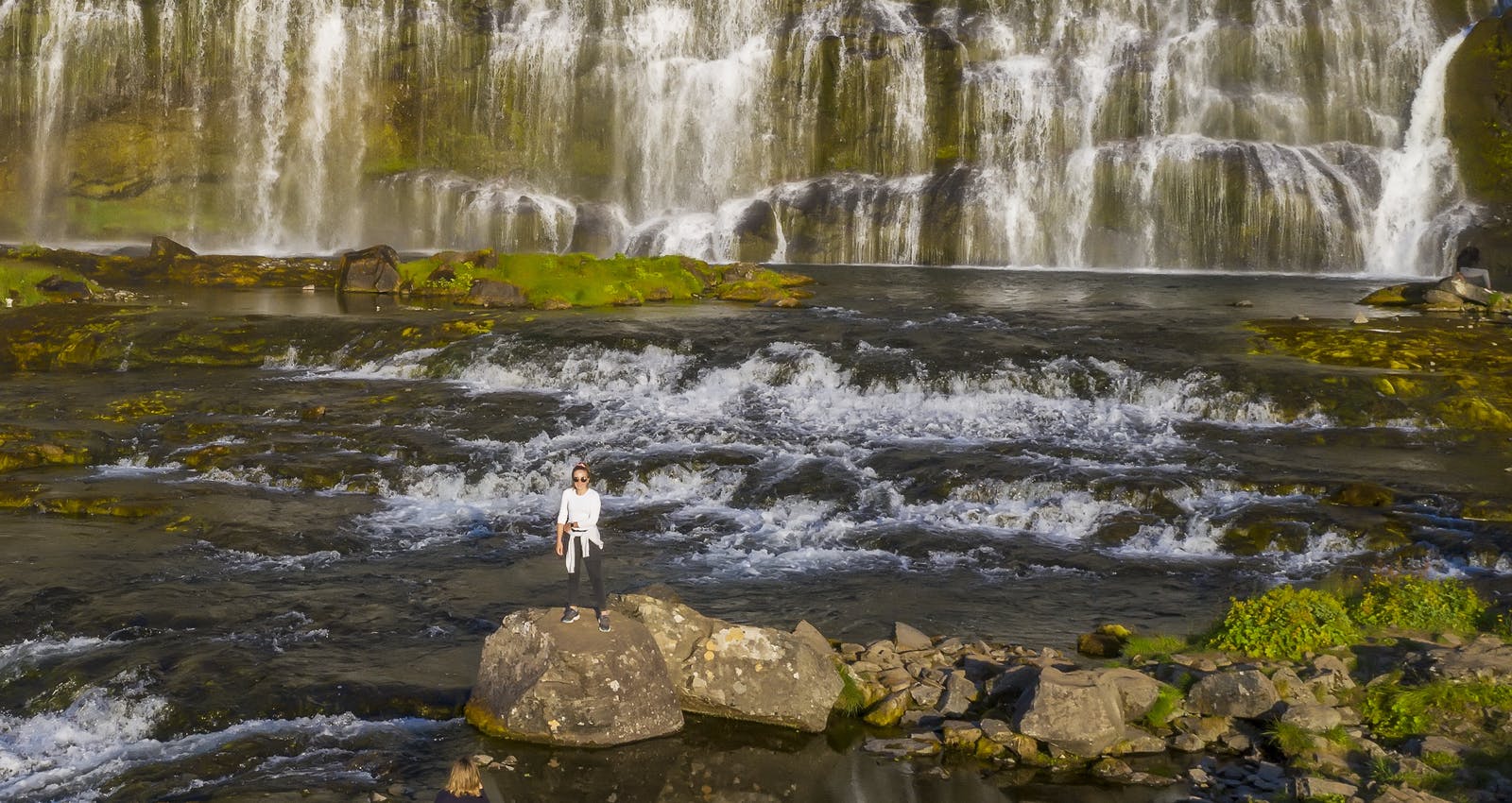
As the Westfjords often get hit by harsh winters, and the main road leading to Dynjandi actually closes during winter - it is only recommended to visit this waterfall during summer and autumn. The best month to visit Dynjandi waterfall is between June and September.
Experience Waterfalls
If you want to experience waterfalls, rivers and lakes but do not have time to travel outside Reykjavík - then no worries. Perlan Museum in Reykjavík has exhibitions covering all aspects of Icelandic Nature. And a whole exhibition only for Water in Iceland. Here, you can learn about the significance of the different types of bodies of water and their impact on forming the island and its nature.
How To Get to Dynjandi From Reykjavík
Getting to Dynjandi from Reykjavík involves quite a long journey. It is a total of 353 (approximately 220 miles) kilometres for the shortest route, taking about 5 hours non-stop under normal circumstances.
Be aware that road conditions in Iceland, especially in the Westfjords, can vary, and some parts may be gravel roads. It's advisable to check road conditions and weather before starting your journey. Ensure that your vehicle has sufficient fuel for the journey, as gas stations may be less frequent in the Westfjords. Additionally, stock up on supplies before heading into more remote areas.
In addition to Dynjandi, there are notable sites such as the Hornstrandir Nature Reserve and the Látrabjarg birdwatching cliffs. Hornstrandir stands out as the most sparsely inhabited region of the country, offering breathtaking vistas and serving as a habitat for a plethora of Arctic Foxes.
On the other hand, Látrabjarg is renowned as the optimal location for observing puffins from the mainland, as they nest there in staggering numbers, reaching the tens of thousands.
- Head north on Route 1, also known as the Ring Road. This is a well-maintained and major highway that circumvents the island.
- Continue on Route 1, driving north and then west towards the Westfjords. The road will take you through various landscapes, including lava fields and coastal areas.
- As you approach the Westfjords, you will reach the town of Bifröst.
- Shortly after passing Bifröst, take a left onto Route 60, also known as Vestfjarðarvegur.
- Stay on Route 60 for the remaining 241 kilometres (approximately 150 miles).
- You will reach the designated parking area for Dynjandi, and from here, it is a short hike to the waterfall.
FAQ
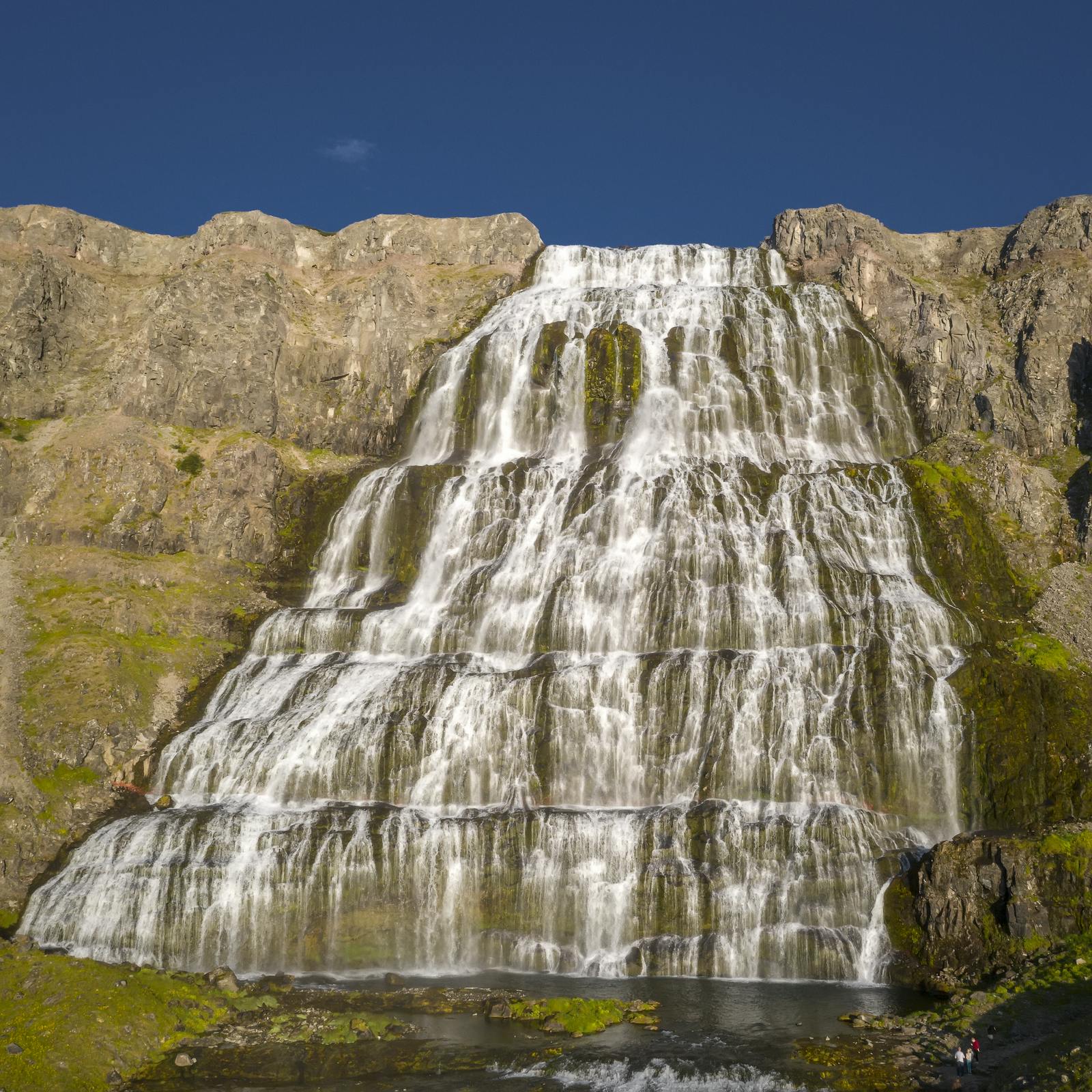
What Does Dynjandi Mean?
The name "Dynjandi" translates to "thunderous" or "resounding" in Icelandic.
How Long Is The Walk to Dynjandi Waterfall?
The walk to Dynjandi waterfall involves a trail that takes you through a series of smaller waterfalls before reaching the main one. The entire hike is approximately 2 kilometres (about 1.2 miles) long, and it can take around 15 to 30 minutes to reach the top, depending on your pace and the amount of time you spend enjoying the various cascades along the way.
How Far Is Dynjandi Waterfall From Reykjavík?
The driving distance is approximately 370 kilometres (230 miles). The journey can take around 5 to 6 hours, depending on road conditions.
What Part Of Iceland Is Dynjandi Waterfall?
Dynjandi is situated in the Westfjords, which is the northwestern part of Iceland. The region is known for its stunning landscapes, fjords, and remote beauty.
Popular articles

Reykjanes Volcanoes Overview
Enjoy a complete overview of the Reykjanes Volcanoes from 2021-2024. Learn about its geology, recent activity, and visitor tips for a safe, memorable experience.

Reykjanes Peninsula Volcanoes: Sundhnúksgígar Eruptions
The anticipated volcano has erupted in the Reykjanes Peninsula, the site is being called Sundhnúkagígar. See the historic insights on the seismic activity and volcanic eruptions.

Earthquakes in Iceland
Earthquakes in Iceland are a fact of life. Each year, hundreds of small tremors shake the earth, a reminder of the country’s position on a tectonic plate boundary.

Volcano Museums and Exhibitions in Iceland
If you don't manage to visit an actively erupting volcano in Iceland - Experience its force at one of these excellent volcano museums and exhibitions in Iceland.

Top 10 Places To See the Northern Lights in Iceland
You can see the northern lights across the country, but some spots are more suitable than others. Find the best place to see the northern lights in Iceland.

Ice Caves From Reykjavik
Travel beyond the capital for a closer look at an ice cave under one of Iceland’s glaciers. If you can’t spare the time, experience Perlan’s ice cave in Reykjavik.